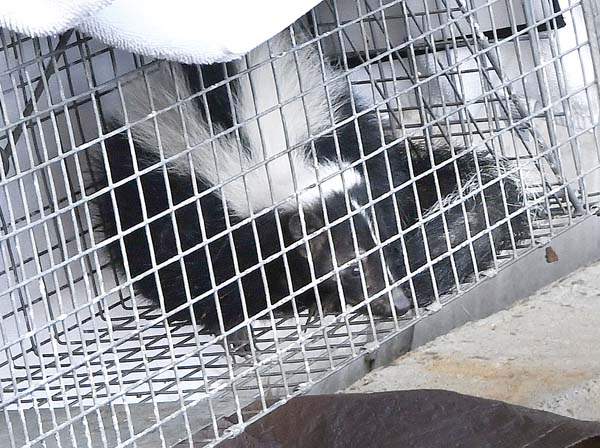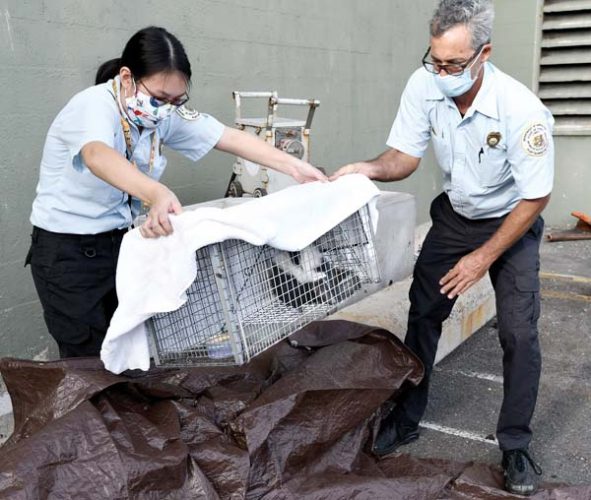State Agriculture Department Plant Quarantine Inspectors Erika Magarifuji and Matthew Olbert carefully transfer a captured skunk to their truck Tuesday morning at Kahului Harbor. The Maui News / MATTHEW THAYER photos
KAHULUI — A wildlife ecologist performing annual seabird awareness and response work at Kahului Harbor was surprised to find a skunk hiding in a tight cranny along the wall of Pier One Shed early Tuesday morning.
Harbors Maui District Manager Duane Kim said the ecologist was looking for seabirds when the skunk was spotted between a large concrete block and an octagonal concrete piling lying next to the wall. Harbor security was notified around 1:30 a.m. and contacted Harbor Management.
A maintenance worker was sent to the management office to pick up a cat trap from the Maui Humane Society already on hand. Baited with a can of tuna, the trap was placed near the skunk, but the animal did not enter until later in the morning.
When state Department of Agriculture officials arrived at about 8 a.m., harbor security had cornered the animal and prevented it from escaping, the department said in a news release Tuesday.
DOA Plant Quarantine Inspectors Matthew Olbert and Erika Magarifuji were able to lure the skunk into the cage. Although the animals are known for spraying a foul scent, this one kept its olfactory defenses on hold as Olbert and Magarifuji partially covered the cage with a towel, placed it on a plastic tarp and carefully loaded it into the bed of their truck.

Using a can of tuna and a cat trap from the Maui Humane Society, workers captured a skunk that was spotted at the harbor early Tuesday morning.
As they worked, a small crowd of harbor employees and Matson Company employees looked on.
Kim said there was no telling how long the animal had been at the harbor or exactly how it reached there.
“We don’t know,” Kim said. “We suspect it came from one of the shipping companies.”
The skunk measured about 15 inches from head to tail, according to the department. A test for rabies will be sent to a Mainland laboratory.
Inspectors surveyed the area and found no other skunks. They are looking into how and when the skunk could have made its way to Maui.
The skunk was euthanized later in the day, Kim confirmed.
Skunks are native to North and South America and are considered invasive species in Hawaii. They are omnivorous, which means they eat both plant and animal material, including bird eggs. According to the Centers for Disease Control and Prevention, skunks are the third most frequently reported rabid wildlife species in the U.S., trailing bats and raccoons.
They are only allowed in Hawaii by permit for research and exhibition in a municipal zoo, according to the DOA.
Maui’s last skunk sighting was in August of 2018, when one was found by workers of a trucking company unloading a container of ceramic tiles in Kahului. After reportedly smelling an odor and spotting a “critter,” the workers closed the container and waited for State Agriculture personnel to capture it.
In February 2018, stevedores at Pier 1 at Honolulu Harbor made the first recorded capture of a live skunk in Hawaii.
Both skunks found that year tested negative for rabies.
Sightings or captures of illegal and invasive species should be reported to the state’s toll-free pest hotline at 643-PEST (7378).
* Matthew Thayer can be reached at [email protected].


